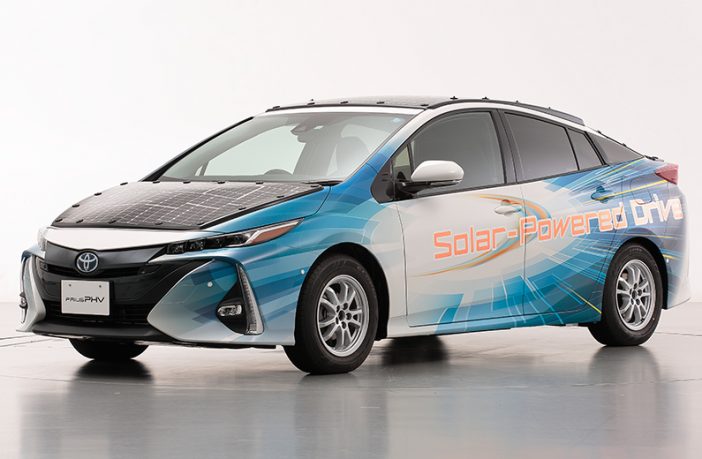- Research and development organization NEDO and the battery manufacturer Sharp have teamed up with the Toyota Motor Corporation (Toyota) to run trials aim to assess the effectiveness of improvements in cruising range and fuel efficiency of electrified vehicles equipped with high-efficiency solar batteries.
Toyota plans to conduct the trials under various driving conditions in Toyota City, Aichi Prefecture, Tokyo, and other areas later this month . Various data, including the power generation output of the solar battery panel and the amount the drive battery is charged, will be obtained and verified, and then used in the development of an onboard solar recharging system.
The solar cell modules will be installed on the roof, hood and tailgate of the Prius PHEV. The integrated solar panels are designed to improve the range and fuel efficiency of the compact model.
According to the Toyota announcement, the cells have a conversion efficiency of over 34 percent. Over the entire area, the solar power system is to have a rated an output of 860 watts. The output is 4.8 times greater when compared to the Prius plug-in hybrid currently on offer.
Another new feature of the test vehicles is that they will generate electricity while driving on the road. Toyota hopes that this will result in longer ranges in electric mode. However, the standard consumption of the Prius-PHEV is already 7.2 kWh/100 km – during the journey, the solar system can only contribute a small part of the current consumption, even in sunny weather.
Table 1: Performance comparison of the commercial and demo model Prius PHV
| Performance items | Vehicle | |
|---|---|---|
| Prius PHV (Solar charging system) |
Demo car | |
| Solar battery cell conversion efficiency | 22.5% | 34%-plus |
| Rated power generation output | 180 W | Approx. 860 W |
| Maximum charge to the driving battery while the vehicle is parked (per day)* | BEV-mode cruising range equivalent to 6.1 km | BEV-mode cruising range equivalent to 44.5 km |
| Maximum charge and power supply to the drivng and auxiliary battery while the vehicle is being driven (per day)* | Supplies power only to auxiliary battery, which powers the car navigation system, etc. | BEV-mode cruising range equivalent to 56.3 km |
| * | Maximum amount of charge generated by the solar charging system while the vehicle is parked or being driven, converted into travelling distance according to the JC08 Japan test cycle. Calculated based on the Japan Photovoltaic Energy Association Labeling Guidelines (FY2016), taking into account the various losses incurred in onboard systems. Solar radiation amount calculated based on the daily data of the average year between 1990 and 2009 in the Nagoya district (source: NEDO). |
|---|
Author: Bryan Groenendaal
Source: Toyota















